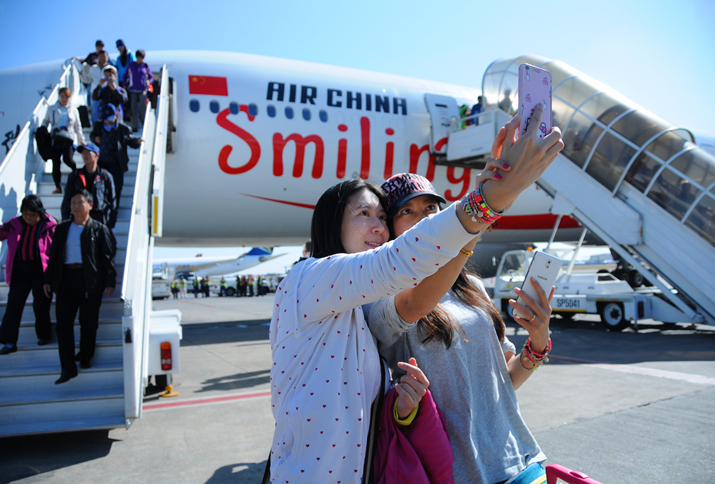|
|||||||||||
|
|
| Shape Shifting Economy |
| Looking back at 2015 and forward to 2016 vis-a-vis the China-Africa economic relationship |
| By Hannah Edinger | VOL. 8 February 2016 |
 |
| Direct flights between Johannesburg and Beijing resumes in November 2015 |
 |
The year kicked off with what is now a long-standing tradition - a multi-African-country visit by China’s Foreign Minister Wang Yi as the first visit abroad each year. With Wang’s stopover in Kenya, Sudan, Cameroon, Equatorial Guinea and the Democratic Republic of the Congo, where he followed up on the commitments made to these countries, China continued to signal the importance of Africa in its foreign commercial policy.
However, the African landscape had already undergone a transformation at the time of Wang’s visit. A number of resource-producing economies were feeling the pinch of a declining commodity price environment. Oil prices had effectively halved by January 2015 from June 2014 levels. After trading at $100 per barrel, oil in 2015 averaged around $50 per barrel, given the global glut in the market.
Other commodity prices followed suit, linked to slower Chinese growth, depressed commodity demand, and an oversupply in the market. To date, this has had serious implications for African commodity exporters, given their structural over-reliability on earnings from oil to copper, iron ore and coal. More than three quarters of African economies depended on natural resources (fossil fuels, metals, minerals etc.) for over 90 percent of their export revenues in 2013.
China’s stock market hiccups and currency devaluation added greater concerns to other global economic headwinds mid-year. And the expectations of rate normalization in the United States too played out on the continent. African currency depreciations against the U.S. dollar wiped billions off their respective economies, increased their cost of imports, tightened country budgets and expenditure planning and depressed their growth outlook. It came as little surprise when the International Monetary Fund reduced Sub-Saharan Africa’s GDP growth expectations for 2015 to 3.8 percent in October (recovering to 4.3 percent in 2016).
China as key financier
With extractive industry projects generally subdued, China continued to be an important financier and builder of infrastructure on the continent, especially in the transport (railway) and energy (power generation) sectors. Dilapidated rail lines, outdated rolling stock, and a greater focus on regional integration have seen a need for sizable investment into rail projects across Sub-Saharan Africa, some of which came online in 2015. One milestone, for example, was the inauguration of the Benguela Railway in Angola. Built by China Railway after breaking ground in 2004, the 1,300-km railway was completed in early 2015. A few months later, China Railway also completed its first light rail project in Africa. By mid-2015, China Civil Engineering Construction Corp. had completed more than half of the 756-km railway line it was building with China Railway in Addis Ababa, which will create a trade route between Ethiopia and Djibouti.
China’s rail project activities further span Kenya and Nigeria, as well as South Africa, host to Sub-Saharan Africa’s most developed and sizable rail network. China has become an important partner of South Africa’s state-owned rail, port and pipeline company Transnet, and has contributed to local industrial capacity building in the sector.
The first batch of 85 electric locomotives (of a total 1,064) bought from China and built in South Africa was delivered in March 2015. Three months later, it was announced that China Development Bank would fund and support Transnet’s railway recapitalization program to the tune of $1.82 billion over 15 years, making it the first state-owned entity in South Africa to access sizable Chinese funding.
China’s ongoing power-sector play in Africa addresses the well-publicized energy deficit, energy being one of the most important ingredients for positioning the continent toward value-added industry development. Chinese firms in 2015 continued to be involved in a diversity of power projects and committed to working on cross-border projects in East Africa, as well as renewable projects in Ghana, Kenya, Tanzania and South Africa.
Aviation connectivity has also been an area of cooperation, enabling economic activity between China and the continent. Direct flights between Johannesburg and Beijing resumed in November last year. This came at the same time when the number of Chinese tourists to South Africa saw a sharp drop. In fact, Chinese tourist numbers recorded the largest decrease in the country’s foreign visitor numbers between June 2014 and the same month in 2015 on account of stricter visa regulations. South Africa eased these rules in October 2015. East Africa’s air connectivity with China was also propelled with the launch of a direct flight between the two.
Cooperation framework
Upon closer examination, these power and transport projects and agreements align to the cooperation framework signed between China and the African Union (AU) at the onset of 2015. The framework emphasizes deeper infrastructure cooperation, particularly transport infrastructure, to assist regional integration and the industrialization efforts of the continent as part of the AU’s Agenda 2063.
On China’s side, the activities also link to its Belt and Road Initiative as Chinese firms look to offshore some of their additional capacity in various heavy industries.
The year aptly came to a close with President Xi Jinping acknowledging China’s support toward Africa’s industrialization and economic diversification efforts at the Forum on China-Africa Cooperation (FOCAC) Summit in Johannesburg. Held in early December, the summit, attended by heads of state, marked a high point in the Sino-African calendar. As one of the most noteworthy investors and financiers of Africa’s development, China committed a further $60 billion in funding, three times the commitment made at FOCAC 2012, including the launch of a new, dedicated $10-billion industrial capacity cooperation fund. Beyond the commitments by the political leadership, the key business discussion points included a shift toward more equity-based cooperation models and a focus on Chinese manufacturing investment in diversified sectors.
It is likely that 2015 will have served as a landmark in charting a more symbiotic policy direction for the fast-changing Chinese economy in its engagement with the African continent that, to date, is home to the largest number of least industrialized economies.
Knock-on effects in 2016
However, with a declining currency and capital outflows signaling lower confidence in the Asian powerhouse’s growth story, China’s own economic performance will continue to be monitored closely by the world in 2016 as policy efforts to stabilize the situation continue. A further fall in China’s currency could have a number of knock-on effects for the global economy, especially for Africa, such as eroding African economies’ relative export competitiveness by boosting that of China’s exports. It could also lessen the purchasing power of Chinese companies abroad and see possible further downward pressure on commodity prices, including oil.
But this needs to be weighed up against deflationary effects on the import side and the fact that most commercial transactions between China and the continent, despite the signing of some currency swap agreements, remain dollar-denominated (although the U.S. dollar strengthened substantially against various African currencies).
Undoubtedly though, the changing structure of China’s economy and the resultant growth trajectory will continue to be a hot topic in global economics. It will not only test China’s commercial engagements with other leading commercial powers but with Africa too.
Given these developments, the likely maturing and shifting nature of this relationship should be embraced by African policymakers by implementing reforms that will enhance domestic productivity and economic diversification, away from an over-reliance on resource exports, through emphasizing industrial cooperation with China and other partners. For countries that play their policy cards appropriately, the next few years could be a game changer for their own economic development.
(The author is associate director at Frontier Advisory Deloitte. The opinions expressed in this article are those of the author and do not necessarily reflect those of Deloitte.)
|
||||||||||||
|
|||
| Copyright ChinAfrica All right reserved 京ICP备08005356号 |